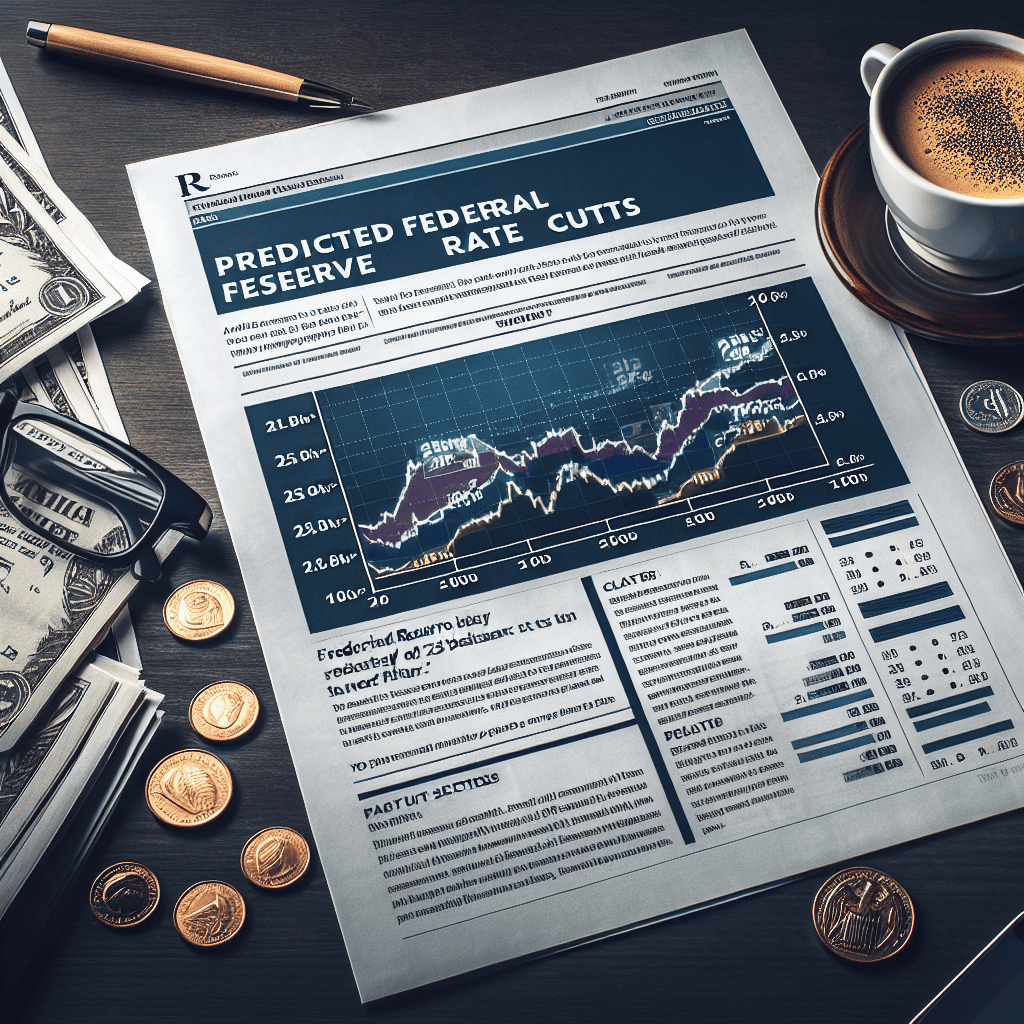“Goldman Sachs Forecasts: A Series of 25 Basis Point Fed Rate Cuts on the Horizon”
Introduction
Goldman Sachs, a leading global investment banking and financial services firm, has recently forecasted a series of 25 basis point interest rate cuts by the Federal Reserve in the near future. This prediction comes amid evolving economic conditions and signals a potential shift in monetary policy aimed at addressing concerns over economic growth and inflation. The anticipated rate cuts reflect Goldman Sachs’ analysis of current economic indicators and the Fed’s strategic response to maintain economic stability. As markets and investors closely monitor these developments, the implications of such monetary policy adjustments are expected to have significant impacts on financial markets and the broader economy.
Impact Of Fed Rate Cuts On The U.S. Economy
Goldman Sachs has recently forecasted a series of 25 basis point rate cuts by the Federal Reserve, a move that could have significant implications for the U.S. economy. As the central bank adjusts its monetary policy, the ripple effects are expected to be felt across various sectors, influencing everything from consumer spending to business investments. Understanding the potential impact of these rate cuts requires a closer examination of how they might affect economic growth, inflation, and financial markets.
To begin with, interest rate cuts typically aim to stimulate economic activity by making borrowing cheaper for consumers and businesses. When the Federal Reserve reduces rates, it lowers the cost of loans, encouraging individuals to take out mortgages, car loans, and other forms of credit. This increase in borrowing can lead to higher consumer spending, which is a critical driver of economic growth. As people spend more on goods and services, businesses may see increased revenues, potentially leading to expansion and job creation. Consequently, the anticipated rate cuts by the Fed could provide a much-needed boost to the economy, especially if it is facing headwinds from global uncertainties or domestic challenges.
Moreover, lower interest rates can also have a profound impact on business investments. Companies often rely on borrowing to finance new projects, expand operations, or invest in research and development. With reduced borrowing costs, businesses may find it more attractive to pursue these opportunities, leading to increased capital expenditures. This, in turn, can enhance productivity and innovation, contributing to long-term economic growth. Furthermore, as businesses invest more, the demand for labor may rise, potentially reducing unemployment and increasing wages. Therefore, the Fed’s decision to cut rates could foster a more favorable environment for business growth and employment.
However, it is essential to consider the potential downsides of rate cuts, particularly concerning inflation. While moderate inflation is generally seen as a sign of a healthy economy, excessively low interest rates can lead to overheating, where demand outpaces supply, causing prices to rise rapidly. If inflation becomes too high, it can erode purchasing power and create instability in the economy. The Federal Reserve must carefully balance its rate cuts to avoid triggering runaway inflation while still supporting economic growth.
In addition to these economic factors, the financial markets are likely to react to the Fed’s rate cuts. Typically, lower interest rates can lead to higher stock prices as investors seek better returns than those offered by bonds and other fixed-income securities. This shift in investment preferences can drive up equity markets, benefiting investors and potentially boosting consumer confidence. However, it is crucial to note that market reactions can be unpredictable, and other factors, such as geopolitical tensions or changes in global economic conditions, can also influence market dynamics.
In conclusion, Goldman Sachs’ prediction of multiple 25 basis point Fed rate cuts suggests a proactive approach by the Federal Reserve to support the U.S. economy. While these cuts could stimulate consumer spending and business investments, thereby fostering economic growth, they also carry the risk of inflationary pressures. Additionally, the financial markets are likely to respond to these changes, with potential implications for investors and overall economic sentiment. As the situation unfolds, careful monitoring and analysis will be essential to understanding the full impact of these monetary policy adjustments on the U.S. economy.
How Goldman Sachs’ Predictions Influence Market Sentiment
Goldman Sachs, a leading global investment banking, securities, and investment management firm, has recently forecasted a series of 25 basis point rate cuts by the Federal Reserve. This prediction has significant implications for market sentiment, as investors and analysts closely monitor the Federal Reserve’s monetary policy decisions to gauge the future direction of the economy. Understanding how Goldman Sachs’ predictions influence market sentiment requires an examination of the interconnectedness between interest rates, investor behavior, and economic expectations.
To begin with, interest rates set by the Federal Reserve play a crucial role in shaping economic activity. Lower interest rates generally encourage borrowing and spending by businesses and consumers, thereby stimulating economic growth. Conversely, higher rates tend to dampen economic activity by making borrowing more expensive. Therefore, when Goldman Sachs predicts multiple rate cuts, it suggests an expectation of a more accommodative monetary policy aimed at supporting economic expansion. This expectation can lead to shifts in market sentiment as investors adjust their portfolios in anticipation of changes in borrowing costs and economic conditions.
Moreover, Goldman Sachs’ predictions carry weight due to the firm’s reputation and influence in the financial industry. As a major player with extensive research capabilities, its forecasts are often regarded as credible and insightful. Consequently, when Goldman Sachs projects rate cuts, it can sway investor sentiment by reinforcing or challenging prevailing market narratives. For instance, if the market is already anticipating a slowdown in economic growth, Goldman Sachs’ prediction of rate cuts might bolster the belief that the Federal Reserve will act to counteract potential downturns. This can lead to increased confidence among investors, who may view the anticipated rate cuts as a proactive measure to sustain economic momentum.
In addition, the anticipation of rate cuts can have a direct impact on various asset classes. For equities, lower interest rates typically enhance the attractiveness of stocks by reducing the discount rate applied to future earnings, thereby increasing their present value. As a result, Goldman Sachs’ prediction of rate cuts could lead to a rally in stock markets as investors seek to capitalize on the potential for higher valuations. Similarly, in the bond market, expectations of rate cuts can drive down yields, as investors anticipate lower future interest rates. This can result in increased demand for existing bonds, pushing their prices higher.
Furthermore, the foreign exchange market is also sensitive to interest rate expectations. Lower interest rates in the United States relative to other countries can lead to a depreciation of the U.S. dollar, as investors seek higher returns elsewhere. Consequently, Goldman Sachs’ prediction of rate cuts might influence currency traders to adjust their positions, potentially leading to fluctuations in exchange rates.
In conclusion, Goldman Sachs’ prediction of multiple 25 basis point Fed rate cuts has a profound influence on market sentiment. By shaping expectations around monetary policy, these forecasts can drive investor behavior across various asset classes, from equities to bonds and currencies. As market participants digest these predictions, they adjust their strategies to align with anticipated changes in economic conditions and interest rates. Ultimately, the interplay between Goldman Sachs’ forecasts and market sentiment underscores the complex dynamics that govern financial markets and the pivotal role that influential institutions play in shaping investor perceptions.
Historical Analysis Of Fed Rate Cuts And Economic Recovery
Goldman Sachs’ recent prediction of multiple 25 basis point Federal Reserve rate cuts has sparked considerable interest among economists and market analysts. To understand the potential implications of such monetary policy adjustments, it is essential to examine the historical context of Fed rate cuts and their impact on economic recovery. Historically, the Federal Reserve has utilized interest rate cuts as a tool to stimulate economic growth during periods of economic downturn or uncertainty. By lowering the federal funds rate, the Fed aims to reduce borrowing costs, thereby encouraging consumer spending and business investment. This, in turn, can help to boost economic activity and mitigate the effects of a recession.
One notable instance of this strategy occurred during the financial crisis of 2008. In response to the severe economic contraction, the Federal Reserve implemented a series of aggressive rate cuts, eventually bringing the federal funds rate to near-zero levels. This accommodative monetary policy, combined with other measures such as quantitative easing, played a crucial role in stabilizing financial markets and setting the stage for a gradual economic recovery. The subsequent years saw a slow but steady improvement in economic indicators, including GDP growth and employment rates.
Similarly, during the early 2000s, the Fed responded to the dot-com bubble burst and the subsequent economic slowdown by reducing interest rates. These rate cuts helped to alleviate the economic strain and contributed to a period of sustained growth in the mid-2000s. However, it is important to note that the effectiveness of rate cuts can vary depending on the broader economic context and the specific challenges facing the economy at any given time.
In the current economic landscape, characterized by lingering uncertainties and potential headwinds, Goldman Sachs’ forecast of multiple 25 basis point rate cuts suggests a proactive approach by the Federal Reserve to support economic stability. While the precise timing and magnitude of these cuts remain speculative, the historical precedent indicates that such measures could provide a cushion against potential economic slowdowns. Moreover, the anticipated rate cuts could have significant implications for various sectors of the economy. Lower borrowing costs may encourage increased consumer spending, particularly in interest-sensitive areas such as housing and durable goods. Additionally, businesses may find it more attractive to invest in expansion and innovation, potentially leading to job creation and productivity gains.
However, it is also crucial to consider potential challenges associated with rate cuts. For instance, prolonged periods of low interest rates can lead to asset bubbles and excessive risk-taking in financial markets. Furthermore, the effectiveness of rate cuts may be limited if other structural issues, such as supply chain disruptions or geopolitical tensions, continue to exert downward pressure on economic growth.
In conclusion, Goldman Sachs’ prediction of multiple 25 basis point Fed rate cuts underscores the importance of understanding the historical context of such monetary policy actions. While past experiences suggest that rate cuts can play a vital role in supporting economic recovery, their success depends on a range of factors, including the broader economic environment and the specific challenges at hand. As the Federal Reserve navigates these complexities, the potential for rate cuts to stimulate growth and stability remains a topic of keen interest and analysis among economists and policymakers alike.
Potential Benefits For Borrowers From Fed Rate Reductions

Goldman Sachs has recently forecasted a series of 25 basis point rate cuts by the Federal Reserve, a development that could have significant implications for borrowers. As the Federal Reserve adjusts its monetary policy, the potential benefits for borrowers become increasingly apparent. Lower interest rates can lead to reduced borrowing costs, which in turn can stimulate economic activity by encouraging both consumer spending and business investment. This anticipated shift in monetary policy could provide a much-needed boost to various sectors of the economy, particularly those that are sensitive to interest rate changes.
To begin with, one of the most immediate benefits of a reduction in the federal funds rate is the decrease in interest rates on various types of loans. For instance, mortgage rates are closely tied to the federal funds rate, and a series of rate cuts could lead to lower mortgage rates. This would make homeownership more affordable for many individuals, potentially increasing demand in the housing market. As a result, prospective homebuyers might find it easier to secure financing, thereby stimulating activity in the real estate sector. Additionally, existing homeowners could benefit from refinancing opportunities, allowing them to reduce their monthly mortgage payments and free up disposable income for other expenditures.
Moreover, lower interest rates can also positively impact consumer loans, such as auto loans and personal loans. With reduced borrowing costs, consumers may be more inclined to make significant purchases, such as buying a new car or undertaking home improvement projects. This increase in consumer spending can have a ripple effect throughout the economy, boosting sales for businesses and potentially leading to job creation. Furthermore, lower interest rates can alleviate the financial burden on individuals with existing debt, as they may be able to refinance their loans at more favorable terms, thereby reducing their overall debt servicing costs.
In addition to benefiting individual borrowers, businesses stand to gain from a series of rate cuts as well. Lower interest rates can reduce the cost of capital for businesses, making it more attractive for them to invest in expansion projects, research and development, or other growth initiatives. This can lead to increased productivity and competitiveness, ultimately contributing to economic growth. Small businesses, in particular, may find it easier to access credit, enabling them to expand their operations and hire additional employees. Consequently, the labor market could experience positive effects, with potential reductions in unemployment rates and improvements in wage growth.
Furthermore, the anticipated rate cuts could have implications for the stock market. Lower interest rates often lead to higher stock valuations, as investors seek higher returns in equities compared to fixed-income securities. This can result in increased investor confidence and potentially drive up stock prices, benefiting those with investments in the market. However, it is important to note that while lower interest rates can provide numerous benefits, they also carry certain risks, such as the potential for inflationary pressures or asset bubbles. Therefore, it is crucial for policymakers to carefully monitor economic conditions and adjust their strategies accordingly.
In conclusion, Goldman Sachs’ prediction of multiple 25 basis point Fed rate cuts presents a range of potential benefits for borrowers. From reduced borrowing costs for individuals and businesses to increased economic activity and improved market conditions, the implications of such monetary policy adjustments are far-reaching. As the Federal Reserve navigates these changes, borrowers and investors alike will be closely watching to capitalize on the opportunities that arise.
Challenges For Investors Amidst Predicted Rate Cuts
Goldman Sachs has recently forecasted a series of 25 basis point rate cuts by the Federal Reserve, a prediction that has sparked considerable discussion among investors and financial analysts. This anticipated shift in monetary policy comes at a time when the global economy is grappling with a myriad of challenges, including inflationary pressures, geopolitical tensions, and the lingering effects of the COVID-19 pandemic. As such, investors are now faced with the task of navigating an increasingly complex financial landscape, where the implications of these potential rate cuts could be both profound and multifaceted.
To begin with, it is essential to understand the rationale behind Goldman Sachs’ prediction. The investment bank’s analysts suggest that the Federal Reserve may opt for rate cuts as a means to stimulate economic growth and counteract any potential downturns. Lower interest rates typically encourage borrowing and spending, which can, in turn, boost economic activity. However, this strategy is not without its risks. For instance, reducing rates could exacerbate existing inflationary pressures, a concern that has been at the forefront of economic discussions in recent months. Consequently, investors must weigh the potential benefits of rate cuts against the possibility of rising inflation, which could erode purchasing power and impact investment returns.
Moreover, the prospect of rate cuts presents a unique set of challenges for fixed-income investors. Traditionally, lower interest rates lead to a decrease in bond yields, which can diminish the attractiveness of fixed-income securities. As a result, investors may need to reassess their portfolios and consider alternative strategies to achieve their desired returns. This could involve diversifying into other asset classes, such as equities or real estate, which may offer higher potential returns in a low-rate environment. However, such a shift also entails increased exposure to market volatility and risk, factors that must be carefully managed to preserve capital and achieve long-term financial goals.
In addition to the impact on fixed-income investments, potential rate cuts could also influence equity markets. Historically, lower interest rates have been associated with higher stock prices, as cheaper borrowing costs can lead to increased corporate profits and investment. Nevertheless, the current economic climate is characterized by significant uncertainty, and the relationship between interest rates and stock market performance may not be as straightforward as in the past. Investors must remain vigilant and consider a range of factors, including corporate earnings, geopolitical developments, and consumer sentiment, when making investment decisions.
Furthermore, the global nature of today’s financial markets means that the effects of U.S. monetary policy are likely to be felt beyond its borders. Emerging markets, in particular, could experience increased capital inflows as investors seek higher yields in a low-rate environment. While this may provide a boost to these economies, it also raises the risk of capital flight and currency volatility, should the Federal Reserve’s policy stance change unexpectedly. Consequently, investors with international exposure must be prepared to navigate these potential challenges and adjust their strategies accordingly.
In conclusion, Goldman Sachs’ prediction of multiple 25 basis point Fed rate cuts presents both opportunities and challenges for investors. As they navigate this evolving landscape, it is crucial for investors to remain informed and adaptable, carefully considering the implications of monetary policy changes on their portfolios. By doing so, they can better position themselves to achieve their financial objectives amidst the uncertainties of the current economic environment.
Comparison Of Goldman Sachs’ Forecast With Other Financial Institutions
Goldman Sachs, a leading global investment banking, securities, and investment management firm, has recently forecasted a series of 25 basis point rate cuts by the Federal Reserve. This prediction has sparked considerable interest and debate within the financial community, as it contrasts with the expectations of several other prominent financial institutions. To understand the implications of Goldman Sachs’ forecast, it is essential to compare it with the projections of other financial entities and analyze the potential impact on the economy.
Goldman Sachs’ prediction is rooted in its analysis of current economic indicators and the Federal Reserve’s monetary policy objectives. The firm anticipates that the Fed will implement multiple 25 basis point cuts in response to slowing economic growth and persistent inflationary pressures. This outlook suggests that Goldman Sachs expects the central bank to adopt a more accommodative stance to stimulate economic activity and maintain price stability. However, this perspective is not universally shared among financial institutions, leading to a divergence in forecasts.
In contrast to Goldman Sachs, some financial institutions, such as JPMorgan Chase and Morgan Stanley, have adopted a more conservative outlook regarding the Federal Reserve’s future actions. These institutions predict fewer rate cuts or even a pause in rate adjustments, citing concerns over potential overheating of the economy and the risk of exacerbating inflation. Their forecasts are based on the belief that the current economic conditions, while challenging, do not warrant aggressive monetary easing. This divergence in predictions highlights the complexity of the economic landscape and the varying interpretations of data by different analysts.
Moreover, the International Monetary Fund (IMF) and the World Bank have also weighed in on the matter, offering their perspectives on global economic trends and monetary policy. While these organizations do not provide specific forecasts for U.S. interest rates, their reports emphasize the importance of balancing growth and inflation. They caution against overly aggressive rate cuts, which could undermine financial stability and lead to unintended consequences in global markets. This cautious approach aligns more closely with the views of institutions like JPMorgan Chase and Morgan Stanley, further illustrating the spectrum of opinions on the issue.
The implications of Goldman Sachs’ forecast are significant for both domestic and international markets. Should the Federal Reserve follow the path of multiple rate cuts, it could lead to lower borrowing costs, potentially boosting consumer spending and business investment. However, it could also result in a weaker U.S. dollar, affecting international trade dynamics and capital flows. Investors and policymakers must carefully consider these potential outcomes as they navigate the evolving economic environment.
In conclusion, Goldman Sachs’ prediction of multiple 25 basis point Fed rate cuts stands in contrast to the more cautious outlooks of other financial institutions. This divergence underscores the uncertainty and complexity of the current economic landscape, as analysts interpret data and trends in varying ways. As the Federal Reserve continues to assess its monetary policy options, the differing forecasts serve as a reminder of the challenges inherent in predicting economic outcomes. Ultimately, the central bank’s decisions will have far-reaching implications, influencing not only the U.S. economy but also the broader global financial system.
Long-term Implications Of Multiple Fed Rate Adjustments
Goldman Sachs, a leading global investment banking, securities, and investment management firm, has recently forecasted a series of 25 basis point rate cuts by the Federal Reserve. This prediction comes amidst a backdrop of evolving economic conditions and signals a potential shift in monetary policy. Understanding the long-term implications of these anticipated rate adjustments is crucial for investors, businesses, and policymakers alike.
To begin with, the Federal Reserve’s decision to adjust interest rates is typically driven by its dual mandate to promote maximum employment and stable prices. In periods of economic uncertainty or sluggish growth, the Fed may opt to lower interest rates to stimulate borrowing and investment. Goldman Sachs’ prediction of multiple rate cuts suggests that the firm anticipates a need for such economic stimulation in the near future. This expectation is likely rooted in a combination of factors, including global economic trends, domestic economic indicators, and potential geopolitical risks.
As the Federal Reserve implements these rate cuts, one immediate effect is likely to be a reduction in borrowing costs for consumers and businesses. Lower interest rates generally make it cheaper to finance large purchases, such as homes and automobiles, and can encourage businesses to invest in expansion and development. This, in turn, can lead to increased consumer spending and business activity, potentially boosting economic growth. However, while the short-term benefits of rate cuts are often clear, the long-term implications require careful consideration.
One potential long-term consequence of sustained low interest rates is the risk of inflation. As borrowing becomes more affordable, the increased demand for goods and services can lead to upward pressure on prices. If inflation rises too quickly, it can erode purchasing power and destabilize the economy. Therefore, the Federal Reserve must balance the need for economic stimulation with the risk of overheating the economy. Goldman Sachs’ prediction of gradual, 25 basis point cuts suggests a cautious approach, aiming to support growth without triggering excessive inflation.
Moreover, prolonged periods of low interest rates can have significant implications for savers and investors. On one hand, lower rates can diminish returns on savings accounts and fixed-income investments, such as bonds. This can pose challenges for individuals relying on interest income, particularly retirees. On the other hand, low rates can drive investors to seek higher returns in riskier asset classes, such as equities or real estate. This shift in investment behavior can lead to increased market volatility and the potential for asset bubbles.
Furthermore, the anticipated rate cuts could have implications for the global economy. As the United States adjusts its monetary policy, other central banks may respond in kind to maintain competitive exchange rates and support their own economic objectives. This interconnectedness underscores the importance of coordinated policy efforts and international cooperation in addressing global economic challenges.
In conclusion, Goldman Sachs’ prediction of multiple 25 basis point Fed rate cuts highlights the complex interplay between monetary policy and economic conditions. While these adjustments may provide short-term economic support, the long-term implications warrant careful consideration. Policymakers must navigate the delicate balance between fostering growth and maintaining stability, while investors and businesses must adapt to an evolving financial landscape. As the situation unfolds, ongoing analysis and strategic planning will be essential to mitigate risks and capitalize on opportunities in this dynamic environment.
Q&A
1. **What is Goldman Sachs predicting about the Federal Reserve’s interest rate policy?**
Goldman Sachs is predicting multiple 25 basis point rate cuts by the Federal Reserve in the near future.
2. **Why does Goldman Sachs believe the Fed will cut rates?**
The prediction is likely based on economic indicators suggesting a slowdown or the need to stimulate economic growth.
3. **When does Goldman Sachs expect these rate cuts to begin?**
The specific timing of the rate cuts is not detailed, but they are anticipated in the upcoming monetary policy meetings.
4. **How many rate cuts is Goldman Sachs forecasting?**
Goldman Sachs is forecasting multiple rate cuts, though the exact number is not specified.
5. **What impact could these rate cuts have on the economy?**
Rate cuts typically aim to lower borrowing costs, stimulate investment and spending, and support economic growth.
6. **How might these rate cuts affect the stock market?**
Rate cuts can lead to increased stock market activity as lower interest rates make equities more attractive compared to bonds.
7. **What sectors might benefit from the predicted rate cuts?**
Sectors such as real estate, consumer discretionary, and financials might benefit from lower borrowing costs and increased consumer spending.
Conclusion
Goldman Sachs anticipates that the Federal Reserve will implement several 25 basis point rate cuts in the near future. This prediction suggests that the bank expects economic conditions to warrant monetary easing, potentially due to slowing economic growth, lower inflationary pressures, or other financial market dynamics. Such rate cuts would aim to stimulate economic activity by making borrowing cheaper, thereby encouraging spending and investment. However, the timing and extent of these cuts will depend on evolving economic indicators and the Fed’s assessment of the economic outlook.





